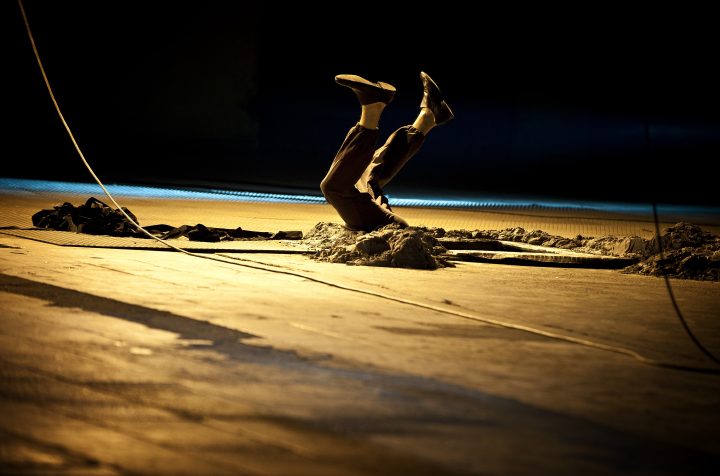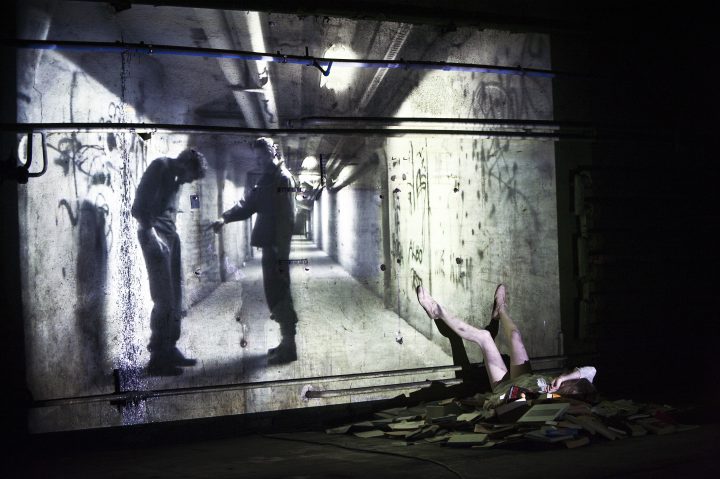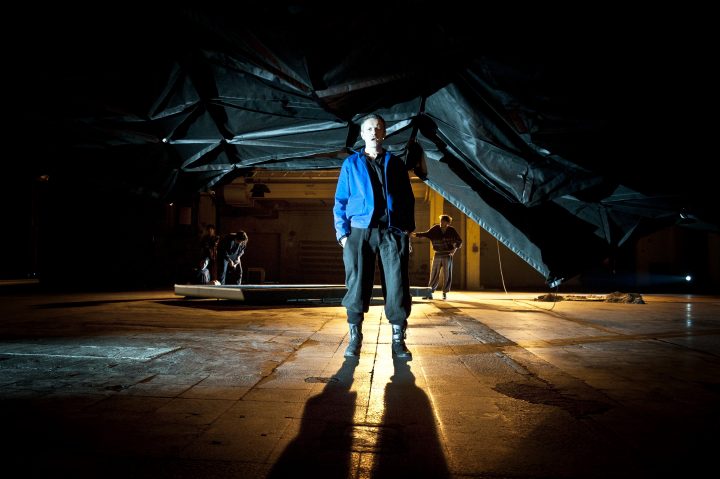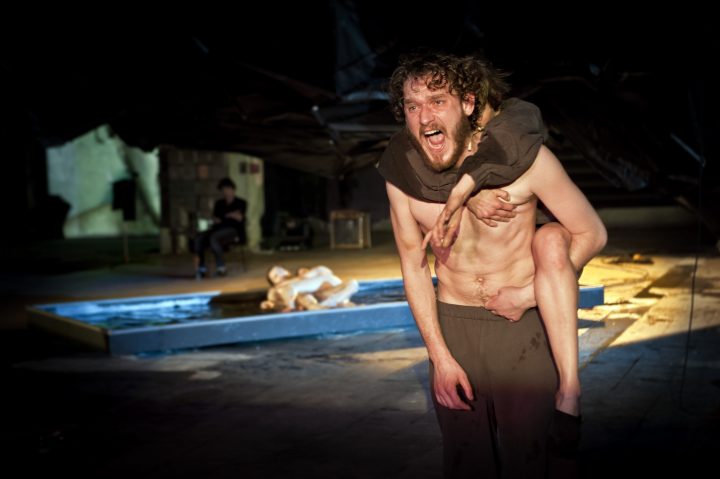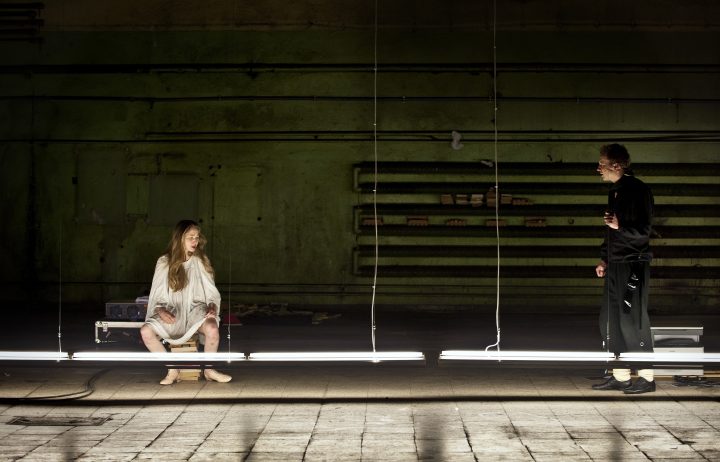Dorota Sosnowska, Dorota Sajewska
Body As Medium. Between Theory and Technology of Theatre
Paper Body as Medium. Between Theory and Technology of Theatre, conference:„Bodies on Stage. Acting Confronted by Technology”, Sorbonne 3 (Paris, June 3rd–5th, 2015)
Peggy Phelan, in her famous text Ontology of Performance, asserts that “Performance cannot be saved, recorded, documented, or otherwise participate in the circulation of representations of representations: once it does so it becomes something other than performance. […] Performance […] becomes itself through disappearance.”[1] What she is saying here also is that body itself cannot be saved, recorded or documented; it becomes itself only through unmediated presence that can be experienced by other bodies. The performing body is singular and ephemeral, present and real. At the same time she explains: “In performance, the body is metonymic of self, of character, of voice, of ‘presence.’ But in the plenitude of its apparent visibility and availability, the performer actually disappears and represents something else – dance, movement, sound, character, ‘art.’”’[2] How should we understand this? What is the body on stage if it is not the “body per se”? The answer given by Phelan is not very satisfying. Performance becomes a metaphysical category with its ephemerality that transcends a mortal body. Becoming itself through disappearance, performance is pure experience, not anchored in any kind of materiality. But looking closer at her text, one can see that all the examples she analyzes are not classical performances. She chooses artworks that are literally based on the use of different media and different technologies. In the very center of every work recalled by Phelan there is a problem of presence, which becomes questionable and unsure. Cindy Sherman (Film-stills) dresses herself in various costumes to become an image of the body photographed and hung on the wall. She is herself and not-herself at the same time, touching the classical problem of impossible dualism between the actor and the character she embodies. Angelika Festa in the work Untitled Dance (with fish and others), which is a key example for Phelan, changes her body into the static figure while the “performance” is taking place on the screen where different projections enter into the complicated game with the body and its ability to endure. One screen presents the image, which is delayed in relation to the “real time” presence of the body. Time is in question here, as is the presence itself, but it is only visible via technology, which becomes here a tool of mediation. Phelan, in her examples, is defending a thesis that is almost the opposite of the one formulated at the beginning of her essay: performance becomes itself through mediation.
What is surprising, moving from performance to the field of theater theory, is that one can find similar thinking. In one of the most important books about theater theory, Samuel Weber states that theatricality, as the oldest form of dealing with the problem of the body and its presence, should be understood literally as medium.[3] The author – looking at theatricality in its media dimension, which enhances its status of being “in between,” its functioning that escapes any certainty, any permanent nature or unifying approach – views theatricality as an alternative to Western philosophical thought, perceived as totalizing, building permanent identities, excluding otherness, and founded on the metaphysics of presence. Weber, in the footsteps of Plato, finds in the theater a subversive power that is capable of undermining the Western desires to survey reality with a single common-to-all and integrative view. This potential is also the reason why – from Antiquity up to the present day (as exemplified by Debord) – the theater is now and then presented as a destructive activity whose product is a show that beguiles us and obscures the truth. For Weber, on the other hand, it is this mediation between concealment and revelation, between truth and fiction (a feature much deprecated by Western thought) that is the unique lesson we can learn from the theater. This specific art practice – in contrast to the classical understanding of a work of art – can never be ultimately defined, since it is in a state of constant circulation between production and reception. It is this movement that takes place not only between an actor and a spectator, the body and the participant in the performance, but also between the corporeal and the fictitious, the concurrent being here and there. It is the movement that stretches one’s presence between the past and the present, and is a harbinger of the future. It destroys cohesion, unity, and coherence. It is a heterogeneous medium. The theater is not a means of presenting an identity, or self-presence, but a condition that must be fulfilled and, as Weber puts it, “must take place.” It is a location determined by the place. And since this perspective, as determined by the place, is by design entangled in artificiality, it induces us to take falsehood for reality. While instantly raising suspicion, it reminds us of the relativity of the place we occupy. Theatricality as a medium challenges all the systems.
In the chapter titled Scene and Screen: Electronic Media and Theatricality Weber states that:
One of the traits that distinguishes electricity as a source of energy, at least insofar as it pertains to the electronic media, is its tendency, by virtue of its velocity, to transform traditional experiences of space and time, of distance and proximity, and hence of bodies, which in great part are defined through their spatio-temporal mode of being situated. What would seem to be specific to theater, by contrast, and presumably also to theatricality, as both are traditionally construed, is their dependence upon the ‘Euclidean’ experience of space-time that the electronic media tend to relativize if not to abolish: above all, recourse to the opposition between presence and absence as well as to that of proximity and distance in the situating of bodies, especially living bodies.[4]
Doesn’t this mean that the so-called “new media” used on the stage question not only our experience of the body in its relation to traditional notions of space and time, but also, they deny the privileged place of the body on the stage? The body is no more present than any other medium used in the theatrical performance. In Weber’s perspective, not only does theatricality become a medium, but the body itself – oppressed or emancipated by technology, depending on the stand we take – becomes a medium between presence and disappearance, between materiality and ephemerality, between reality and fiction.
[1] Phelan, Peggy. Unmarked: The Politics of Performance, Routledge, New York, 1993, p. 146.
[2] Ibid., p. 150.
[3] Weber, Samuel. Theatricality as Medium, Fordham University Press, New York, 2004.
[4] Ibid., p. 99.
Rychcik
In 2014 Radosław Rychcik received one of the most prestigious cultural prices in Poland for his theatrical realization of Adam Mickiewicz’s Dziady. This play, written between 1822 and 1860 when Poland was under partitions and didn’t exist on the map, is fundamental to Polish national identity. It is a romantic, phantasmatic vision of Poland seen as a metaphysical space where the freedom of the whole universe is fought for. It was one of the most important dramas for the 1960s and 1970s Polish theater, and in Rychcik’s reading, this 19th-century text is once again shown as important statement about the contemporary world. This intention is inherent in Polish theater, but this time the way Dziady was staged is very interesting.
The first scene introduces a character, which in Mickiewicz’s vision is a pagan priest, a shaman who conducts old Slavic rituals for the souls of the dead and the condemned. In Rychcik’s spectacle he becomes the Joker, literally taken from the Batman Dark Knight movie. Later we see Marilyn Monroe, two twin sisters from Stanley Kubrick’s The Shining, NBA players and – at the very heart of Rychcik’s concept – a choir of black bodies. Polish national drama is presented as a metaphor of emancipation – especially that of the Civil Rights movement in the United States. In the most important scene, the “Great Improvisation” (the climax of the drama, and in Polish tradition, the greatest speech in the play) is presented on a screen. This is the scene from the movie by Tadeusz Konwicki in which the “Great Improvisation” is declaimed by legendary actor Gustaw Holoubek, who played in Dziady in 1967. That spectacle was banned by the government, and is considered as the beginning of widespread student protests in Poland in 1968. In Rychcik’s show it becomes a kind of monument–an (unfortunately) uncritically presented ruin of past theater and national history, which cannot be resurrected and haunts from the screen as a powerful ghost of our identity. When the action returns to the stage, the “Great Improvisation,” recounted by the “living” actor, changes into Martin Luther King’s speech: “I had a dream….” It is supposed to become new, but in fact, it is the same old paradigm of freedom for Poles. Before he starts to speak, naked black and white actors slowly surround him. They gather and become a choir of slaves supervised by the Joker. Moved by the speech, they start to sing the song about revenge taken from Dziady, but in the style of an old gospel song. They move from one foot to another. As a crowd they are powerful, beautiful and dangerous. We feel their power, which is coming from their bodily presence, the unmediated contact (in contrast to the projection we’ve just seen) with multiplied singing and moving bodies. The scene ends with the sound of rain, which becomes a symbol of freedom.
But what is striking in this moment is the real provenance of the blackness – transposed as a notion of slavery and emancipation to the white bodies – on the stage of Polish national drama. In Poland there is no meaningful black minority. We know blackness from images, movies, photos. With the Joker, Marilyn, NBA and other figures, it should be read in the context of a particular technological mode in which Rychcik’s work function – the television.
An old television set is almost always present on the stage. It shows some hypnotic images, fragments of Lost Highway by David Lynch, and some kind of control screen making our status as an audience deeply unsure. Isn’t this a looped highway, which in Žižek’s reading is the psychoanalytic scene of phantasms more real than what we see on the stage? Or maybe the stage is only the function of the television screen, and it absorbs all its two-dimensional characters, mixing and re-mixing them in this strange constellation, which is supposed to be the image of our freedom? And if the television is really a frame for the entire story, how does it change the status of naked white and black bodies that are supposed to be present and live in confrontation with the ghostly screen?
Samuel Weber in his book Mass Mediauras. Form, Technics, Media writes,
What television transmits is not so much images, as is almost always argued. It does not transmit representations but rather the semblance of presentation as such, understood as the power not just to see and to hear but to place before us. Television thus serves as a surrogate for the body in that it allows for a certain sense-perception to take place; but it does this in a way that no body can, for its perception takes place in no more than one place at the time. Television takes place in taking the place of the body and at the same time in transforming both place and body.[1]
This is why the confrontation of the body and the screen doesn’t really take place on the stage. Screen, which in Rychcik’s case is strictly connected to the television and its mode of representation, doesn’t allow the body to build itself as a living and breathing being. At the same time we cannot say that black bodies become just an image. Their mode of being is strictly “televised” – they are bodies in place of the bodies, they mediate between body and its presence, between experience of the body and its stage existence. The strongest scene of the performance is in fact the one that is less “live.”
On the deeper level of the performance, a dangerous and strongly ambivalent idea appears. For Rychcik, the blackness, treated strictly as a characteristic of the body and not as an idea of the subject, was supposed to guarantee the bodily presence of the actors on the stage. He confronted the television and its mode of representation–so important for our era when television doesn’t really need the television set anymore–with one moment of true presence. The fact that it was supposed to be secured by the color of the skin, that the fight for emancipation was supposed to become current because it was translated into black people’s fight, seems very questionable. In fact it seems like a repetition of the colonial gesture described by postcolonial thinkers: “As Fanon noted many years ago, this is the inescapable ‘fact’ of blackness […] which forces on ‘negro’ people a heightened level of bodily self-consciousness, since it is the body which is the inescapable, visible sign of their oppression and denigration.”[2] In Rychcik’s Dziady the discourse of freedom is mixed with the discourse of authenticity, and in theatrical reading it becomes the desire of true bodily presence. But this presence can only happen if the body itself is treated as another–different, exotic and attractive because unknown and un-understood. So the body can reach its presence if it is deprived of its political subjectivity, if it becomes a slavery existence placed on the stage for us to look at. This logic of Rychcik’s concept uncovers something that is valid for all the theater/performance discourse – the ambivalence of the “live presence.” Here, put in the context of race, it unveils itself in a very powerful way.
As observed earlier, the body, confronted with technological mode of representation, is not the real body anymore. There is no pure presence. The mediation appears then as a truly subversive and emancipatory power that saves the body, replacing it with the unfinished chain of repetitions, re-enactments and reconstructions that mark the stage as a space of action.
[1] Weber, Samuel. Mass Mediauras. Form, Technics, Media, Stanford University Press, Stanford, 1996, p. 117.
[2] Ashcroft, Bill, Gareth Griffiths and Helen Tiffin (ed.). The Post-colonial Studies Reader, Routledge, London, 1995, p. 321.
Garbaczewski
Krzysztof Garbaczewski’s and Marcin Cecko’s 2011 play The Sexual Life of Savages is the first instance in which famous Polish-British anthropologist Bronisław Malinowski’s legendary work, along with his A Diary in the Strict Sense of the Term, were adapted for the stage. Above all though, it is an attempt to explore the body confronted with new technologies as well as with the post-anthropocentric discourse. It does so in order to pose a question on the status of the savage-body in contemporary mass media culture, and, simultaneously, to undertake a critical review of temporality and history. “Savages. There was such a tribe. I remember. I used to be a part of it”[1] – these words set in motion the exploration of the memory of the Other as a part of oneself. For this purpose, Garbaczewski and Cecko cast a group of young uncompromising actors who, in real life as well, formed a kind of artistic tribe in a laboratory of sorts in the space of Warsaw’s former Dom Słowa Polskiego printing house. Its labyrinthine architecture – while being incredibly suggestive because of its overwhelming sense of entropy, decay and energy loss – is as ruthless and uncomfortable for the actors as for the spectators. This very performative setting, emanating a sense of emptiness that is impossible to fill, and resembling some kind of cellar, thanks to the dim light given off by the low-hanging lamps, proves the ideal space for studying the memory of a futuristic Savage tribe discovering their own “primality” through the radical use of network technology. The faintly seen and heard actors move about like shadows in the monotonous, hypnotic rhythm of the action. Often, they only allow themselves to be definitively discerned and located through the use of media and projection screens. They challenge the myth of theater being based on “live experience,” as well as the myth of new media understood as “non-living technology.”
The humanity represented in Garbaczewski’s and Cecko’s play, or rather acted out by the modern Savages, falls outside of the scale differentiating man from animal and man from machine. Here, nature does not exist without technology, nor hyperconsciousness without instinct. Studying the ontological status of savages is, however, not an abstract pursuit, but one entrenched in history. “History as fur means a lot,” the character Outsider is told by Aria, a mutant inhabiting a video-projection cave. “With time, your hair grows, becomes thicker. It all comes from knowledge, which you place on this gelatinous mass right here. Through experience forming the shapes underneath the fur.”
The land of the Savages, therefore, exhibits a temporal dimension as well as a historical one – it is a grey zone, a settlement of “civilizational fugitives” who deliberately isolate themselves from economic structures based on production and reproduction. The Savages, critical of modern civilization and in opposition to the values promoted by the capitalist system, yearn to recover the remains of the kula ritual. Their only pursuit is contemplation and free exchange, including offering up themselves and their bodies, oblivious to the concept of ownership. They take from others and share what is their own, creating a non-total unity – “a network of entangled senses, tender, lazy bodies, minds hungry for stimulation.”
This tribe of human copies, animalistic mutants, technological beings thus undermines Malinowski’s extremely rationalistic, biologically-based stance as a researcher on sexuality. In Garbaczewski’s and Cecko’s play, this “ignorance of paternity” that Malinowski treats as a primitive mental state is replaced with a level of technological advancement in which reproduction may occur independently of biology. Here, animism takes the form of techno-animatism, where spirits, memories and the past could be made to return with the use of technology, cloning, and the network-structured reality.
“We can never be sure what our leased bodies will do. And we’re left only with lingering traces, disappearing imprints,” says one of the play’s characters, suggesting that physiological processes are inseparable from the spiritual world, and life from death. In Garbaczewski’s and Cecko’s play, this speculative undercurrent was expressed in a literal fashion, but also philosophically in the set design produced by the visual artist and architect Aleksandra Wasilkowska. She created an autonomous installation, the Black Island, modeled after the map of Papua New Guinea from the year 1600 which Bronisław Malinowski had described in The Sexual Life of Savages. The enormous Black Island has a unique presence in the production; it is a key performer, suspended above the stage and audience, moving throughout the course of the play on the basis of a precise algorithm applied to the movements of the actors and the behavior of the audience. The fictional territory of the Savages was thus conceived as an inverted island–living, migrating and dominating the entire space, it oversaw the process of constant flow and exchange of energy. Thanks to this “concept of a meta-mechanical anti-utopia that is the Black Island” undermining the boundary between the “living bodies” of the audience and cast and the “lifeless objects in the set,” there emerges a certain post-anthropocentric reality dominated by the energy of the earth and territory, as opposed to people and machines. The creator of the installation explained it this way:
The island came about through my fascination with inanimate matter and its ability to self-organise. […] I am fascinated when I image a future situation in which not machines but territory reigns supreme. The mineral world’s rule over human beings. Therefore, I wanted to show that it won’t necessarily be man controlling the territory but rather the territory – its fluctuating magnetic fields, the oil and radioactive waste concealed within it, all of the hidden mineral energy – will start to control us.[2]
And so, here, the island rules over the Savages while, at the same time, being a material manifestation of their “savage” minds. Hovering overhead, the Black Island’s presence is oppressive, but, not fitting into the frame of a supervisory glance, it remains, in a way, invisible. It offers critical commentary on the way in which white society still endeavors to control blackness – by feminizing the black body, white society objectifies and, in effect dehumanizes blackness. By choosing the Black Island as the only sign of blackness in the spectacle, by denying the inscription of race into the real body, the artists give a strong statement about the ambivalence of the bodily presence on stage. The technology used by them is then a critical tool oriented not to emphasize the organic and natural aspects of the “real” body, but to ask about the oppressive dimension of “liveness,” “experience” and “presence” discourse characteristic to theater and to anthropology as well.
[1] All quotations of the play are taken from the unpublished screenplay, provided by Nowy Teatr in Warsaw.
[2] Wasilkowska, Aleksandra interviewed by Jakub Papuczys. “Tworzenie ryzyka,” Didaskalia, 2011, no. 103, p. 89.
Body as a Medium
Returning to the theoretical categories proposed at the beginning, we could say that, paradoxically, the performance that formally seems much more performative than theatrical – Sexual Live of Savages by Garbaczewski – in its reading of the relation between body and technology, in its refusal of the real, in being unmediated and deprived of technology, is much more theatrical than the other example. At the same time Rychcik’s Dziady with its traditional, theatrical form and a shrill understanding of television, emphasizing bodily presence and its experience in the context of emancipation, becomes much closer to Phelan’s definition of performance. Those two ideas of the body confronted by technology on stage go in different directions. If Rychcik’s performative gesture can be read in fact as conservative, then Garbaczewski’s theatrical gesture would be the truly emancipatory one. These are two models of understanding a multidimensional relation between body and media; one could be called anthropocentric and the other post-anthropocentric, offering two different philosophies of the subject.
At the same time this close reading of the body’s status in these spectacles uncovers much more general questions. To fully understand the role of the body that is being transformed by technology, we must return to questions about presence and experience, and include such categories as an actor’s personal body, a body mediated by another medium, or his / her mode technologically alienated from the whole. Such a broader perspective would be approached by the perspective that we have called the “meta-media theory” of the theater. It postulates, following Weber, that the theater be considered as a specific medium that critically comments on other media, and looks at their editing and sequencing strategies. It also incorporates a reflection on the political dimension of annexing media-mediated and media-manipulated corporeality, allowing one to follow the apparently transparent and natural dimension of such actions, whereby, as postulated by Jacques Rancière, it once again it turns aesthetic considerations into political considerations. As Weber states:
[The] irreducible opacity defines the quality of theater as medium. When an event or series of events takes place without reducing the place it “takes” to a purely neutral site, then that place reveals itself to be a “stage,” and those events become theatrical happenings. As the gerund here suggests […] such happenings never take place once and for all but are on-going. This in turn suggests that they can be neither contained within the place where they unfold nor entirely separated from it. They can be said, then, in a quite literal sense, to come to pass. They take place, which means in a particular place, and yet simultaneously also pass away – not simply disappear but happen somewhere else. Out of the dislocations of its repetitions emerges nothing more or less than the singularity of the theatrical event. Such theatrical singularity haunts and taunts the Western dream of self-identity.[1]
The appearance of the Other understood as non-Western subject, as body, as race, as machine, as animal, challenges that self-identity, unveiling the theater and stage as a place of constant meditation and repetition, as a shifting space of possible subversion.
Going in this direction, we would propose that the electronic media and new technologies on the stage are not really a trigger of the great change of the body status. In our opinion, they function more like a deeply critical tool that has made it possible to see and formulate a certain idea that is, in our opinion, inherent to the theater as such. The body on stage is always a medium. It never gains its true presence. This “supplement” that Phelan was talking about could be seen as a surplus of meaning that is always building itself in the context of theater performance. The fact that even for her there is no pure body that can be experienced confirms for us that the performance – as something radically opposite to the conservative medium of theater – is also a superficial construct. That’s why the theoretical proposition of Weber seems so important. Theatricality as a status of space, time and body that are endlessly mediated and shifted, that are always not-here and not-now, that requires taking a stand and a certain point of view (to become a viewer) reveals itself as a political category in a much stronger way than performance, built on the idea of emancipation by ephemerality and immateriality. The idea that the body is always a medium, that it never establishes itself on stage as present in the here-and-now, brings unexpected potential. The strongly subversive status of the body allows it to reveal questions on subjectivity seen in relation to what is dead, inanimate, un-natural, and ultimately in relation to the technological. As shown by Garbaczewski, “We can never be sure what our leased bodies will do. And we’re left only with lingering traces, disappearing imprints.” This could be the new definition of theater seen from the meta-media perspective.
[1] Weber, Samuel. Theatricality as Medium, op. cit., p. 7.
Works cited
Ashcroft, Bill, Gareth Griffiths and Helen Tiffin (ed.). The Post-colonial Studies Reader. London: Routledge, 1995.
Garbaczewski, Krzysztof and Marcin Cecko. The Sexual Life of Savages, 2011 (unpublished screenplay, provided by Nowy Teatr in Warsaw).
Phelan, Peggy. Unmarked: The Politics of Performance> New York: Routledge, 1993.
Wasilkowska, Aleksandra interviewed by Jakub Papuczys. “Tworzenie ryzyka,” Didaskalia, 2011, no. 103.
Weber, Samuel. Theatricality as Medium, New York: Fordham University Press, 2004.
—. Mass Mediauras. Form, Technics, Media, Stanford, CA: Stanford University Press, 1996.
